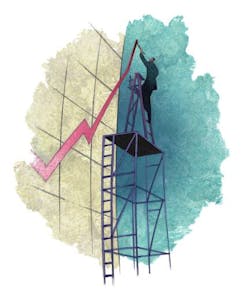For the last three years, the automation business in China has grown at close to 25 percent annually, or about three times the growth rate of the country's gross domestic product (GDP). Fueled by rising export sales, manufacturing accounts for 42.5 percent of the national GDP in China, and has been the backbone of the nation's economy. Now that the General Agreement on Trade of the World Trade Organization (WTO) is being fully implemented this year, China needs a lot of everything. The breaking of monopolies in different sectors will release large purchasing power to the free market. Following the country's entry into the WTO and the introduction of fierce competition from foreign counterparts, local companies are being forced to find ways to improve efficiency and quality.
"China's automation industry is growing extremely fast with so much investment going on," observes Harry Sim, vice president of marketing and business development for Honeywell Process Solutions, a Phoenix-based automation systems supplier. Honeywell's process solutions business is growing three times faster in China than in any other market, Sim adds.
Mega-orders
Most major automation companies claim to have landed at least one mega-order in the range of $20 million to $40 million this year, with several landing a couple of these large projects. Even though China has numerous local automation and instrument companies, they don't have the technology or know-how to run large sophisticated power plants, refineries or steel mills. Further, most large and export-oriented Chinese companies want to buy the latest technology, as a way to help ensure global competitiveness. As a result, large projects typically go to the foreign automation companies, which are all aggressively trying to build market share.
"We have very high ambitions for growth in building automation, especially in China," says Arne Frank, chairman and chief executive officer of Tour Andover Controls (TAC), a subsidiary of France-based Schneider Electric. Schneider has set its sights on becoming No. 1 in China's building automation market.
Backward advantages
According to Albert Li, industrial sector executive at IBM Corp., based in Armonk, N.Y., Chinese companies are marching toward international markets, with their business evolving from simple assembly to research and development. China enjoys the "advantage of backwardness," Li says, which enables it to introduce manufacturing technologies at a cost much lower than when they were originally developed.
High demand for sophisticated automated solutions is particularly evident among state-owned industrial enterprises. Brought up earlier in a protected environment promoting national self-sufficiency, these organizations are now ridden with surplus labor, antiquated technology and inferior products.
Only multinational automation companies with state-of-the-art technology and application expertise are capable of providing energy-efficient, advanced control strategies/systems that could transform the perilous health of these local companies.
Milwaukee-based Rockwell Automation Inc., for instance, hopes to benefit from the growth of the Chinese market. "China is a very important market for us, one that we are absolutely committed to," says Scott Summerville, president of Rockwell’s Asia Pacific operations. China's need to upgrade its manufacturing technologies and management skills and its determination to move up in the value chain from manufacturing provides huge opportunities for the U.S. company.
Cracking the code
The fact is, however, that only a few automation vendors have cracked the code to profitable growth. The keys—according to a recent report from business consulting firm Frost & Sullivan—include low-cost engineering and manufacturing that uses domestic trained resources, local sourcing of quality sub-systems, cultivating political contacts, and packing value-added services in product offerings. The report, titled “Automation Company Strategies in China,” puts automation market revenues in China at $834 million in 2003, rising to $2 billion by 2010.
Automation solution providers can look forward to guaranteed growth in the coming years as the irreversible thrust toward free enterprise gains further momentum. Shrewd investment policies including substantial tax breaks, arranged deals, and ban on imports of competitors' products have resulted in a deluge of foreign direct investment, boosting the demand for automation systems.
About the author
Uday Lal Pai, [email protected], is a freelance writer and editorial consultant based in India.

